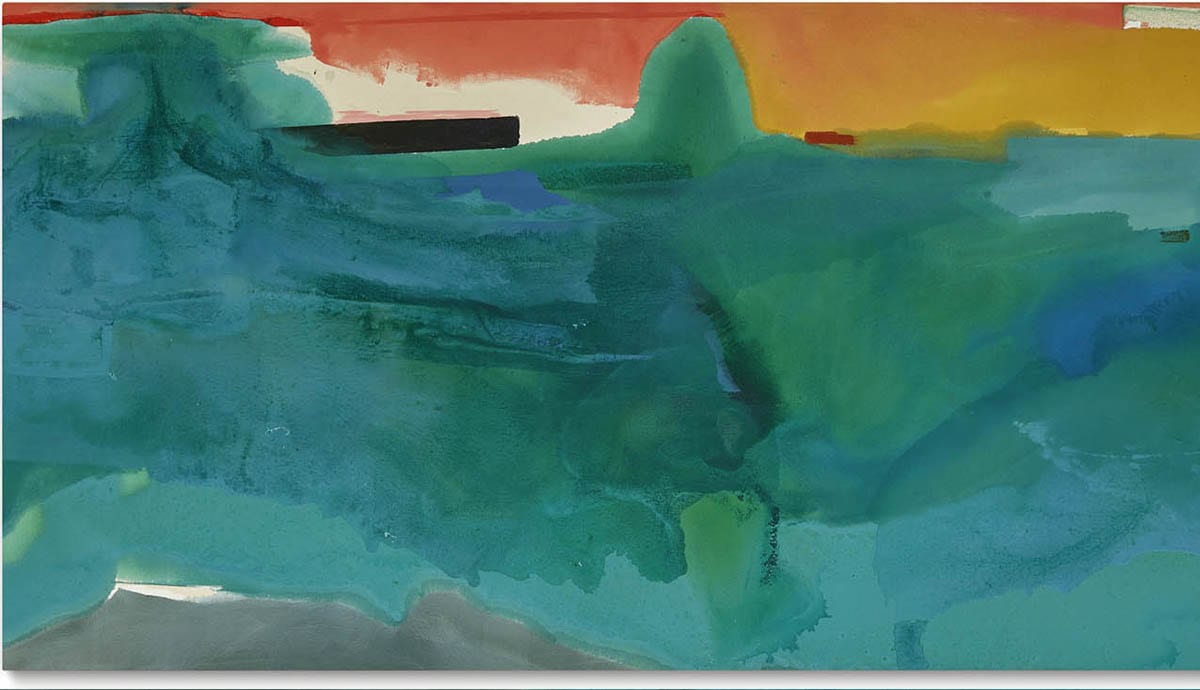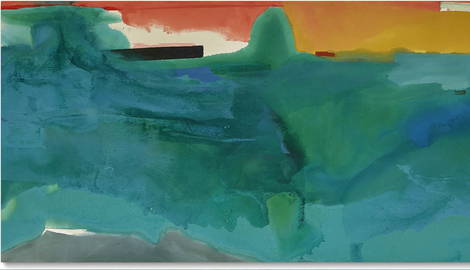
Renowned art critic Clement Greenberg was one of the most influential and respected voices of the 20th century. Known today as the “voice of American art,” his bold and outspoken celebration of American abstract art in the 1940s and 1950s turned artists including Jackson Pollock, Willem de Kooning and Barnett Newman into household names. Believing art should be distilled down into its purest, simplest and most poetic properties of line, colour and flat surface, Greenberg’s ideas influenced an entire generation, leading them to create some of the most iconic artworks of all time. “Modernism,” he wrote, “used art to call attention to art.”
Clement Greenberg’s Early Ideas

Born in the Bronx to Jewish-Lithuanian immigrants, Clement Greenberg studied English Literature at Syracuse University. After graduating he drifted between jobs before finding his way into the band of writers and critics who called themselves the New York Intellectuals, including Susan Sontag and Harold Rosenberg. Many were Jewish and advocated left-wing politics, integrating literary theory with Marxist beliefs, but they rejected Stalin, leaning instead towards the liberalist ideas of Trotskyism.
Many of Greenberg’s ideas initially came from Karl Marx, particularly the belief that abstract avant-garde art was a bold and revolutionary move away from oppressive political regimes led by the Nazis or Communists. Another major influence on Greenberg’s ideas was the German artist and educator Hans Hofmann. In 1938 and 1939 Greenberg went to several of Hoffmann’s lectures which emphasized the importance of a “formal” understanding in art, where color, line, surface, and the relationship between planes on a flat surface were deemed more important than figurative or literary content.
Celebrating the Avant-Garde

Much of Clement Greenberg’s earliest critical writing appeared in New York’s liberal Partisan Review, and was heavily influenced by the ideas of Hans Hoffmann. It was in the Partisan Review that Greenberg published the first of his most influential essays, titled Avant-Garde and Kitsch, 1939, which formed the foundation for many of his future ideas.
In the essay, Greenberg argues that the avant-garde art of the early 20th century was “the only living culture” still in existence, while the emergence of “kitsch”, popular or mass-produced material was a great threat to its existence. Arguing that “kitsch” imagery was a by-product of tacky, cheap industrialized society, he strongly asserted that both art and literature should offer a path to a higher truth beyond this “debased” language. This belief in the societal importance for a “high” avant-garde art focussed on process and experimentation was key in all Greenberg’s ideas about art, coming to inform his future essays on art theory and practice.
A Newer Laocoon
Just one year later, Clement Greenberg published the second of his instrumentally important essays: Towards a Newer Laocoon, 1940. The text was a continuation of Gotthold Lessing’s famous article Laocoon: An Essay Upon the Limits of Painting and Poetry, published in 1766. Lessing had begun making distinctions between different artistic mediums including poetry, painting, and sculpture, arguing how each had its own distinct language of development which we should recognize and appreciate.
Building on Lessing’s essay, Greenberg’s ideas outlined a historical rationale describing where the origins of modern painting had come from and where it was now headed. He argued that painting had been growing increasingly flattened since historical times, moving beyond narrative or literary content towards an emphasis on abstract pattern and surface, writing, “But most important of all, the picture plane grows shallower and shallower, flattening out and pressing together the fictive planes of depth until they meet as one upon the real and material plane which is the actual surface of the canvas.”
Abstract Expressionism

Throughout the 1940s Clement Greenberg settled in the Greenwich Village area of New York where he worked as an editor for Partisan Review, associate editor for Commentary Magazine and critic for The Nation. He was one of the first to spot and champion the work of the burgeoning Abstract Expressionist school including Jackson Pollock, Willem de Kooning, Robert Motherwell and David Smith and through his writing the careers of these artists were launched into an international spotlight. As their careers grew so too did Greenberg’s and he became a giant in the American art scene, taking up lecturing posts at Black Mountain College, Yale University, Bennington College and Princeton University where he had a marked influence upon the next generation of creative thinkers.

The Crisis of the Easel Picture
Several essays published during the 1940s allowed Greenberg to expand his argument for the importance of abstract painting, including Abstract Art, published in 1944, and The Crisis of the Easel Picture, 1948. In the latter text, he introduced the radical and influential concept of the “all-over” picture, describing a flattened, repetitive tendency in American art as practiced by Jackson Pollock, Lee Krasner and Barnett Newman as a “decentralized, polyphonic, all-over painting”, which melted into “sheer texture, sheer sensation.” He also argued that “all-over” painting had come about as a logical reaction to an industrialized, capitalist society, in which “all hierarchical distinctions have been exhausted … no area or order of experience is either intrinsically or relatively superior to any other.”

Greenberg vs. Rosenberg
One of Clement Greenberg’s greatest rivals was his fellow art critic Harold Rosenberg; rumor has it they sometimes nearly ended up in handcuffs during their raucous debates. Though there were many overlaps between their ideas, Rosenberg praised what he called “Action Painting”, a strand of abstraction based on energized, performative gestures as practiced by Jackson Pollock, Franz Kline, and Arshile Gorky. Rosenberg also supported various Abstract Expressionist artists who had brought figurative or narrative elements back into their free, expressive paintings such as Willem de Kooning and Philip Guston.

By contrast, Greenberg pushed forth his support for a purer, cleaner style of abstraction, actively dismissing de Kooning’s latest figurative studies. Instead, he shifted his support towards the Washington Colour School Painters such as Barnett Newman, Kenneth Nolan, and Anne Truitt, who practiced a pared-back, minimal language based on the optical sensations of flat color patterns. In his essay American-Type Painting, 1955, Greenberg argued that this new school of painters was leading a natural progression into true Modernist art.
Modernist Painting
As Clement Greenberg’s ideas developed, they became increasingly polarised and extreme. When the rise of kitsch, multi-layered Pop Art, and Neo Dada styles began to emerge through New York artists Robert Rauschenberg and Jasper Johns, Greenberg fought back even harder. He vociferously fought his argument that Modernist painting must be a process of reduction that disentangled it from other mediums or methods. He further asserted that abstraction was a logical and necessary development in modern art which stripped art back to its barest, most distilled essence, which he described as the natural progression for Formalism, a theory first put forward by art critic Roger Fry in the early 20th century.
These ideas were exemplified in Greenberg’s most iconic essay, Modernist Painting, 1961. He argued that painting should be an ultimately ‘pure’ activity, rejecting any form of reference to the outside world, including emotional expression, illusionism, or any “space that recognizable objects can inhabit.” Greenberg continued to explain how a painting should be entirely self-referential, only relating back to itself and no other outside references to the real world, or to any other artistic medium such as sculpture or drawing.
Post-Painterly Abstraction

Though they were extreme, Clement Greenberg’s ideas reflected the spirit of the times and they had a marked influence on the leading artistic developments of the 1960s. The simplified, saturated Colour Field paintings of Helen Frankenthaler, Morris Louis, and Jules Olitski are synonymous with Greenberg’s ideas today, defining the pinnacle of the Modernist era with a ruthlessly strict, analytical attitude towards form, color, texture, scale, and composition. Greenberg curated an exhibition titled Post-Painterly Abstraction in 1964 at the Los Angeles County Museum of Art which included works by thirty-one different artists; it was so successful that Post Painterly Abstraction is now recognized as a movement in its own right.

Influence on Art Criticism
Building on both his own ideas about Formalism and the theories of the 18th century German philosopher Immanuel Kant, Greenberg argued in Modernist Painting for a new, objective way of seeing art. He believed art should be viewed and written about it in an entirely detached manner, only observing the physical properties of the object itself. These ideas had a profound influence on a new generation of Modernist art critics who became known as the “School of Greenberg”, including Rosalind Krauss, Michael Fried, and Barbara Rose, each of whom adopted a similar analytical approach when dissecting a work of art.
The Backlash Against Clement Greenberg
By the mid-1960s artists and critics were already moving beyond the extremities of Clement Greenberg’s ideas. Many saw his standpoint as too polarised and dogmatic, while his stripping away of illusionism, narrative, and emotion in painting had back the medium into a corner, with nowhere left to go. And as art critic Rosalind Krauss came to realize, Greenberg’s over-simplification of Modernist, Formalist art eradicated much of life’s idiosyncrasies and irrationalities. The disruptive schools of Pop Art and Fluxus that arose in Greenberg’s wake brought many of the complex diversities of ordinary life back into art practices throughout the 1960s and 1970s, shaking apart much of what he had argued so vehemently for.

Although the backlash against Greenberg’s ideas around pure Modernism and Formalism continued for several generations, the emphasis he placed on self-referentiality and the materiality of art objects is an attitude that still persists today. Many of today’s most experimental and exciting contemporary painters have at the back of their mind an awareness of a painting as a physical object, even if they have now flooded it with references to modern life, as demonstrated in the art of Callum Innes, Tomma Abts, Fiona Rae, and Peter Doig.
While Greenberg’s somewhat simplified view of art history as a singular march towards abstraction has largely been rewritten today, his argument that we should see paintings only as themselves first, without relating them to anything else, is an attitude that still lingers in the background today and colours the way so many of us look at art, particularly his belief in art as a unique experience that is “unobtainable from any other source.”








